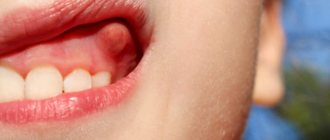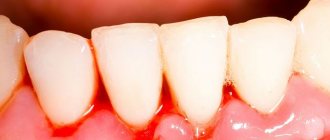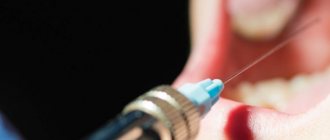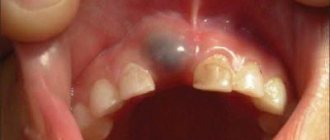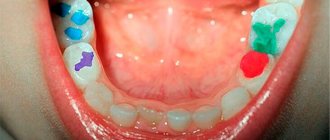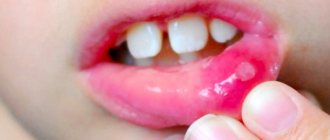Inflammatory gum disease in adults and children is called gingivitis. It is most often observed in children a few months from birth to 13 years of age, which is explained by the characteristics of the child’s body and poor oral hygiene.
According to statistics, in a child from 2 to 4 years old, gum inflammation occurs in 2% of cases, and by the age of 13, the proportion of this disease in children reaches 80%. Gingivitis cured in time does not become chronic, but if left untreated it can cause the development of periodontitis.
Symptoms of gum inflammation in a child
Symptoms of gum disease vary depending on the type and form of the disease. These include:
- bleeding and pain;
- unpleasant odor from the mouth;
- purulent discharge;
- deposits of plaque or tartar;
- hypersensitivity.
Most often, childhood gum disease is associated with the development of gingivitis. The inflammatory process occurs due to poor oral hygiene (bacteria multiply).
REFERENCE! If you have problems with your gums, a visit to the dentist is required. Only a specialist will select an individual treatment algorithm based on the symptoms.
Symptoms of gingivitis in children of various types
The very first symptom of gingivitis is bleeding gums. This is a kind of beacon that signals the beginning of the inflammatory process. However, often this sign goes unnoticed, and the child goes to the dentist only at the stage of an active inflammatory process, manifested by swelling of the gums, which have become bright red, bad breath in the child, pain and burning. Sometimes this condition is accompanied by mild malaise and a slight increase in temperature.
Catarrhal
Most often, children suffer from catarrhal gingivitis. Its chronic form proceeds sluggishly, for a long time, the child practically does not complain of pain, but may refuse to brush his teeth due to the pain that arises in the process. Chronic catarrhal gingivitis usually occurs as a result of poor oral hygiene. There is swelling of the gums, their redness, sometimes single ulcers and cyanosis of the gums. Acute catarrhal gingivitis occurs as a result of an accidental injury to the mucous membrane, a burn, or may be one of the symptoms of a viral disease or allergy. But most often this form of gingivitis occurs during the eruption of baby teeth and their replacement with permanent ones.
Ulcerative
Ulcerative gingivitis can be triggered by an infectious process and hypothermia - for example, if a child spent too much time walking or contracted a viral or bacterial infection from friends in kindergarten or school. But more often it develops as a worsening of the catarrhal form of gingivitis, which was left without treatment. The first symptoms are bleeding, pain and itching in the gums. This is followed by swelling, redness and areas with small ulcers. If this stage of the disease is left untreated, ulcerative necrotic gingivitis will follow, which is characterized by already necrotic areas of the gums with a dirty gray-green coating, putrid odor from the mouth, abundant plaque on the teeth, and viscous saliva. All this leads to intoxication of the child’s body; as a result, he sleeps poorly, is constantly capricious and eats little due to the pain that chewing food causes to his inflamed gums.
Hypertrophic
With hormonal diseases and during puberty, the hypertrophic form of gingivitis is more common in children. This chronic inflammation of the gums is characterized by an overgrowth of gum tissue, which can partially cover the crowns of the teeth. Usually the process covers one or both gums, rarely - only an area limited to several teeth (such localized hypertrophic gingivitis occurs in children due to any anomalies of the dental system).
Atrophic
Atrophic gingivitis is usually caused by improper orthodontic treatment or dental abnormalities. This form of gingivitis is usually localized (found in the area of the lower front incisors and canines). The inflammatory process in atrophic gingivitis is not pronounced, the color of the gums practically does not change, the child does not complain of pain. But over time, the neck of the tooth, and sometimes its root, is exposed, and unpleasant, often painful sensations appear.
Causes of gum inflammation in children
The abundance of causes that cause gum problems can be divided into two large groups.
Common ones include:
- problems with the gastrointestinal tract;
- frequent colds;
- hormonal disorders.
Among the local causes, doctors identify:
- poor-quality fillings (they collapse and injure soft tissues);
- caries (infection from the tooth immediately spreads to the gum);
- incorrectly installed braces;
- crowding of incisors.
Why is gingivitis dangerous in children?
Gingivitis is an inflammation of the gums that occurs as a result of the adverse effects of local and general factors. In children, it occurs quite often: between the ages of two and four years, its prevalence is 2%, and by the age of thirteen, gingival inflammation occurs to one degree or another in 80% of children. Often the disease does not progress beyond gingivitis, since it can be easily cured, avoiding more serious problems. However, if the process is started, the inflammation from the gums will spread to other periodontal tissues (the child will develop periodontitis) and will become a chronic condition, the symptoms of which will need to be relieved with each relapse.
Treatment methods
Some of the common childhood gum diseases include:
- stomatitis (inflammation of the mucous membrane due to a virus or fungus);
- periodontitis (advanced form of gingivitis);
- periodontal disease (associated with inflammation, rarely diagnosed);
- gingivitis (a consequence of injury or plaque, usually occurs in the catarrhal form, during the eruption or change of teeth).
For treatment, local administration of various medications and rinsing with antiseptics may be prescribed. Additional measures: sanitation of the oral cavity and removal of tartar. In the chronic form, physiotherapeutic methods are used.
Types of inflammatory processes
Gingivitis
Inflammation of the gums at the initial stage, that is, not yet spreading to the bone tissue, is called gingivitis.
Treatment of gingivitis in children follows the same principle as in adults, with the only difference being that children are prescribed more gentle medications. When starting the procedure, the hygienist performs professional cleaning, removing plaque and stone, after which he teaches the little patient proper hygiene techniques. Helps you navigate the selection of toothpaste and brush.
Periodontitis
Inflammation of the gums and periodontal tissues - periodontitis - is an advanced stage of gum disease. If left untreated, its progression may result in one or more teeth having to be removed.
Treatment includes occupational hygiene and physical therapy. If the process is advanced, surgical intervention may be required.
Periodontal disease in children
The defeat of all periodontal tissues, in this case, is called childhood periodontal disease. This degree is quite rare. Progression can be triggered by weakened immunity and vitamin deficiency.
An effective option in this case is surgical intervention, as well as strengthening the general condition of the body.
Stomatitis in children
Infectious inflammation of the mucous membrane of the gums, or stomatitis, is characterized by increased sensitivity and discomfort while eating. Therefore, you should show it to a dentist as soon as possible. A dental clinic specialist will examine the baby and prescribe appropriate procedures.
Prevention
The main preventative rule is daily brushing of teeth twice a day (morning and evening). It is important not to forget about the palate and tongue. Please also pay attention to the following recommendations:
- caries is immediately healed (it is advisable not to start the disease in the early stages);
- it is also necessary to treat the disease that could provoke gum inflammation;
- malocclusion needs correction;
- with the help of good nutrition and taking multivitamin complexes according to age, they strengthen the immune system;
- during teething, use a special fingertip to massage the gums;
- food and drink for the baby cannot be too hot or, conversely, cold;
- They explain to their son or daughter that food is always experienced on both sides.
REFERENCE! It is the parents' responsibility to monitor how thoroughly and correctly the child brushes his teeth.
Our specialists at modern pediatric dentistry “Avesta” believe that timely preventive measures help minimize the development of a serious disease. This is the easiest way to keep your baby's gums and teeth healthy.
Diagnosis and treatment of oral lesions in newborns
Infants often develop lesions in the oral cavity, which cause discomfort for themselves and cause anxiety for their parents. The most common disorders and diseases include congenital and neonatal teeth, various oral mucous cysts in newborns, ankyloglossia and congenital epulis of the newborn. In this article we will look at the features of diagnosis and treatment of this type of disorder and try to give readers an idea of the correct methods of treating and counseling young patients and their parents.
During their practice, doctors encounter various cases of oral lesions in newborns: from physiological characteristics associated with the development of the child to cancerous tumors. Awareness of such disorders plays an important role in correct diagnosis, counseling and treatment planning. The purpose of this article is to inform healthcare professionals about the diagnosis and treatment of the most common oral disorders in newborns.
Congenital and neonatal teeth
The eruption of the first baby tooth occurs approximately six months after the baby is born. But some babies reach this age already having congenital (the baby is born with them) or neonatal (erupted during the first month of life) teeth in their mouths.
Almost all congenital teeth (about 90%) erupt in the incisor area of the lower jaw. As a rule, they have the correct shape, but may be characterized by discoloration and an uneven surface. Their typical distinguishing feature already during the development period is increased mobility due to the absence or short length of roots. Most of the congenital teeth are subsequently included in the row of twenty primary teeth, but about 10% of them turn out to be supernumerary. Congenital teeth are rare: one case in two to three thousand births of healthy children, and, as a rule, this deviation is random. But in some cases, the appearance of congenital teeth can be a symptom of certain syndromes, malformations and gingival tumors.
If the congenital tooth turns out to be supernumerary and is not included in the row of baby teeth (this can be determined using an x-ray) or interferes with breastfeeding, it is recommended to remove it. Excessively mobile teeth should also be removed to prevent possible aspiration. In addition, congenital teeth can cause traumatic ulceration of the ventral surface of the tongue (Rigi-Fede syndrome), but this disorder is not an indication for tooth extraction and is cured by smoothing the rough cutting edge of the congenital tooth.
Newborn cysts
To refer to oral mucous cysts in newborns, many terms are used that replace each other, causing some confusion. But, based on the different histogenesis of the lesions, all of them can be divided into two categories: palatal and gingival.
Palatal cyst of a newborn
The palatal plates are bilateral rudimentary processes that join along the midline of the oral cavity in the eighth week of fetal development to form the hard palate. They also fuse with the nasal septum, resulting in complete separation of the oral and nasal cavities. In this case, the connective epithelial lining between the plates is destroyed under the action of enzymes, providing the possibility of fusion of the connective tissue. Neonatal palatal cysts, or Epstein's pearls, form from epithelial inclusions along the fusion line of the palatine plates. This disorder is characterized by high prevalence and is observed in 65%-85% of newborns. Cysts are small (1-3 mm) yellow-white bumps along the palatal suture, especially often located at the junction of the hard and soft palate. Histological examination reveals that these cysts are filled with keratin. No special treatment is required, since the cysts atrophy and disappear soon after their contents are removed.
Gingival cysts of newborns
Gingival cysts develop from the dental lamina (ectodermal ligament), which serves as the basis for the formation of primary and permanent teeth. Its remains can proliferate to form small cysts and subsequently cause the development of various odontogenic tumors and cysts. Depending on the location of formation, cysts that appear on the gums of newborns are called Bohn's nodes (present on the buccal and lingual surfaces of the alveolar ridges) or gingival cysts (formed on the process of the alveolar ridge).
Neonatal gingival cysts have a high prevalence: for example, Taiwanese infants screened within three days of birth had a 79 percent prevalence of the disorder.
Typically cysts look like small whitish lesions of constant size. Those that form on the anterior ridge of the lower jaw can be mistaken for congenital teeth. No separate treatment is required as cysts often rupture due to secondary trauma or friction.
Ankyloglossia
The term “ankyloglossia” (tongue-tied) describes the clinical situations of fusion of the tongue with the floor of the oral cavity or insufficient length of the frenulum of the tongue, limiting its mobility. Ankyloglossia can occur in representatives of various age groups, but is most often observed in newborns. According to research, the frequency of this disorder in newborns ranges from 1.7% to 10.7%, in adults – from 0.1% to 2.1%. Based on this, it can be assumed that some milder forms of ankyloglossia resolve with age.
Ankyloglossia of an infant can cause difficulty in breastfeeding and even cause pain in the nipple area for its mother or wet nurse. The preferred treatment for this disorder in newborns is simple frenectomy, where the frenulum is cut off at its thinnest point with small scissors. The procedure can be performed under superficial anesthesia, which ensures minimal discomfort and reduces the likelihood of bleeding. But bleeding is not necessary. Thus, according to the results of a study involving 215 newborns who underwent frenectomy without anesthesia, 38% of children had no bleeding, and 52% had only a few drops of blood. In 80% of cases, nutrition improved within 24 hours after the start of the procedure.
Congenital epulis of the newborn
This disease is a rare tumor of unknown histogenesis. As a rule, the lesion forms on the alveolar ridge of newborns. The course of the disease is as follows: the tumor does not increase in size from the moment of birth, sometimes it can decrease over time, which indicates a reactive rather than a neoplastic etiology. Most often, this tumor is found in the frontal part of the alveolar ridge of the upper jaw and has the appearance of a round attached formation, usually less than 2 cm in diameter (but sometimes larger ones are found), with a smooth lobulated surface. These types of tumors are more common in girls, which may indicate the influence of hormones, although estrogen and progesterone receptors have not been identified. In 10% of cases, multiple lesions may occur, confirming the need for a thorough oral examination.
As a result of histological studies of congenital epulis, large granular cells with small nuclei were identified. Unlike granular cell tumors, staining with the S100 protein antigen in congenital epulis gives a negative result. Other markers of neurogenic origin also showed negative results, confirming a nonspecific mesenchymal origin of the tumor. Surgical removal is recommended for the treatment of congenital epulis, especially if there is difficulty breathing or feeding problems, or if there is a need for histological confirmation of the diagnosis. For smaller tumors, a wait-and-see approach is acceptable, since cases of spontaneous regression of the tumor are known. There were no cases of relapse, even with incomplete removal of the tumor, or malignant degeneration.
Authors:
Van Heerden, Van Zyl
Causes of childhood gingivitis
This disease is quite common in children, including preschoolers and children of primary school age. Dentists call the main causes of gingivitis:
- accumulation of plaque on teeth (bacteria multiplication is observed when plaque is 1-5 days old);
- inadequate load on teeth and gums - reduced or, on the contrary, increased. This is typical for malocclusion pathology, uneven tooth growth, and crowding;
- mechanical trauma to the gum mucosa, including improper brushing of teeth, use of a brush with hard bristles, inept handling of dental floss;
- a general decrease in the child’s immunity due to acute respiratory viral infections, influenza, hypovitaminosis, and stress.
Gingivitis often occurs in combination with stomatitis, which increases pain and complicates the treatment of the disease.
Gingivitis: treatment and prevention in children
Gingivitis, like any other disease of the teeth and gums, is easier to prevent than to cure. The surest way to prevent it is regular and proper oral care. It is in the mouth that pathogenic bacteria multiply, causing inflammation of the mucous membrane.
Tips for maintaining oral hygiene in children:
- Monitor how your child brushes their teeth. For children under two years old, it is better to carry out this procedure yourself. Remember that the movements of the toothbrush should be “sweeping” - from the base of the gums to the top of the tooth.
- Feed your child healthy, balanced foods. A sufficient amount of protein, fiber and minerals in your baby’s diet will protect him from gum disease. Limit your consumption of sweets and starchy foods.
- If your child has an abnormal bite or abnormal growth of teeth, including crowded or missing teeth, be sure to consult a specialist. Insufficient load or, conversely, overload of teeth and gums can cause gingivitis.
- Use soft toothbrushes with even bristles. Change them regularly - dentists recommend buying a new toothbrush once every three months.
- Be sure to choose toothpaste according to the child’s age.
Don't skimp on teeth and gum care products. After all, treatment will cost much more. An excellent choice is the ASEPTA children's toothpastes; they are available in three versions:
- for children from 0 to 3 years;
- from 4 to 8 years;
- for children over 8 years old.
The composition of each of these pastes fully meets the needs of children's teeth in each age period. They contain calcium in the form of lactate - this is the most easily absorbed form. Children's enamel will not lack this mineral. And the xylitol contained in the paste, a “tooth-friendly” sugar, gives it a sweet, pleasant taste. Unlike adult products, the ASEPTA BABY series does not contain excessive amounts of fluoride and menthol additives.
How to treat gingivitis in children
If you cannot avoid the disease, you must urgently seek help from a dentist. In any case, if you find redness of the gums, swelling or soreness of the mucous membrane, you should consult a specialist. Only a doctor can prescribe treatment. In addition, it is best to begin the fight against this disease by removing plaque and tartar, but this is impossible to do at home.
If you find that your child has red, swollen gums, or if the baby complains of pain in the mouth, be sure to visit the dentist in the coming days. Only a specialist will make an accurate diagnosis and prescribe the right treatment. Don't delay going to the doctor - the situation may get worse!
It is impossible to get rid of gingivitis at home, since gum inflammation can be caused by several reasons, including dental caries, tartar, and others. Before going to the dentist, prepare your child mentally:
- tell us how the dental examination will go;
- do not scare the baby, do not say that it will “not hurt” or “not be scary” - the child may begin to be afraid only because of your words;
- Watch cartoons with your child about going to the dentist.
Pay close attention to creating a menu for your baby during illness. Try to completely eliminate hot and cold foods and drinks, replacing them with warm ones, and also increase the amount of microelements and vitamins (especially groups A, B, C, D) supplied with food, or introduce them additionally into the diet.
If gingivitis is caused by constant mechanical injuries to the mucous membrane, change the child’s toothbrush and stop him from chewing pencils and other objects.
Also teach him how to brush his teeth properly. To do this, you can watch special training videos, which show in a playful way what movements need to be made when cleaning. Regular dental hygiene is the basis for the prevention of any oral diseases.
Gingivitis in children due to weakened immunity is treated etiologically - that is, the main efforts should be aimed at eliminating the cause of the underlying disease. So, if a child often suffers from ARVI or influenza, his diet should be balanced, vitamins, minerals, and lactic acid products should be included. Perhaps you should take more walks in the fresh air.
If your child is experiencing chronic stress, reconsider his daily routine. Perhaps you should give up some clubs or developmental activities, stop going to kindergarten for a while, spend more time with your baby, and reduce the demands on him from teachers or educators. All these measures can help reduce stress and boost the child’s immunity, which, in turn, will prevent gum disease.

